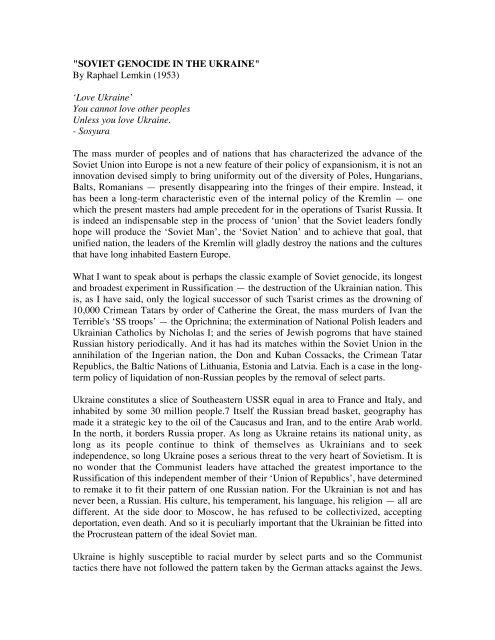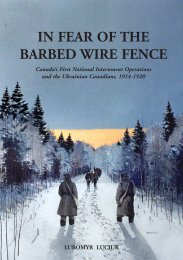"SOVIET GENOCIDE IN THE UKRAINE" By Raphael Lemkin (1953 ...
"SOVIET GENOCIDE IN THE UKRAINE" By Raphael Lemkin (1953 ...
"SOVIET GENOCIDE IN THE UKRAINE" By Raphael Lemkin (1953 ...
- No tags were found...
Create successful ePaper yourself
Turn your PDF publications into a flip-book with our unique Google optimized e-Paper software.
"<strong>SOVIET</strong> <strong>GENOCIDE</strong> <strong>IN</strong> <strong>THE</strong> UKRA<strong>IN</strong>E"<strong>By</strong> <strong>Raphael</strong> <strong>Lemkin</strong> (<strong>1953</strong>)‘Love Ukraine’You cannot love other peoplesUnless you love Ukraine.- SosyuraThe mass murder of peoples and of nations that has characterized the advance of theSoviet Union into Europe is not a new feature of their policy of expansionism, it is not aninnovation devised simply to bring uniformity out of the diversity of Poles, Hungarians,Balts, Romanians — presently disappearing into the fringes of their empire. Instead, ithas been a long-term characteristic even of the internal policy of the Kremlin — onewhich the present masters had ample precedent for in the operations of Tsarist Russia. Itis indeed an indispensable step in the process of ‘union’ that the Soviet leaders fondlyhope will produce the ‘Soviet Man’, the ‘Soviet Nation’ and to achieve that goal, thatunified nation, the leaders of the Kremlin will gladly destroy the nations and the culturesthat have long inhabited Eastern Europe.What I want to speak about is perhaps the classic example of Soviet genocide, its longestand broadest experiment in Russification — the destruction of the Ukrainian nation. Thisis, as I have said, only the logical successor of such Tsarist crimes as the drowning of10,000 Crimean Tatars by order of Catherine the Great, the mass murders of Ivan theTerrible's ‘SS troops’ — the Oprichnina; the extermination of National Polish leaders andUkrainian Catholics by Nicholas I; and the series of Jewish pogroms that have stainedRussian history periodically. And it has had its matches within the Soviet Union in theannihilation of the Ingerian nation, the Don and Kuban Cossacks, the Crimean TatarRepublics, the Baltic Nations of Lithuania, Estonia and Latvia. Each is a case in the longtermpolicy of liquidation of non-Russian peoples by the removal of select parts.Ukraine constitutes a slice of Southeastern USSR equal in area to France and Italy, andinhabited by some 30 million people.7 Itself the Russian bread basket, geography hasmade it a strategic key to the oil of the Caucasus and Iran, and to the entire Arab world.In the north, it borders Russia proper. As long as Ukraine retains its national unity, aslong as its people continue to think of themselves as Ukrainians and to seekindependence, so long Ukraine poses a serious threat to the very heart of Sovietism. It isno wonder that the Communist leaders have attached the greatest importance to theRussification of this independent member of their ‘Union of Republics’, have determinedto remake it to fit their pattern of one Russian nation. For the Ukrainian is not and hasnever been, a Russian. His culture, his temperament, his language, his religion — all aredifferent. At the side door to Moscow, he has refused to be collectivized, acceptingdeportation, even death. And so it is peculiarly important that the Ukrainian be fitted intothe Procrustean pattern of the ideal Soviet man.Ukraine is highly susceptible to racial murder by select parts and so the Communisttactics there have not followed the pattern taken by the German attacks against the Jews.
These attacks on the Soul have also had and will continue to have a serious effect on theBrain of Ukraine, for it is the families of the clergy that have traditionally supplied alarge part of the intellectuals, while the priests themselves have been the leaders of thevillages, their wives the heads of the charitable organizations. The religious orders ranschools, and took care of much of the organized charities.The third prong of the Soviet plan was aimed at the farmers, the large mass ofindependent peasants who are the repository of the tradition, folklore and music, thenational language and literature, the national spirit, of Ukraine. The weapon used againstthis body is perhaps the most terrible of all — starvation. Between 1932 and 1933,5,000,000 Ukrainians starved to death, an inhumanity which the 73rd Congress decriedon 28 May 1934.There has been an attempt to dismiss this highpoint of Soviet cruelty as an economicpolicy connected with the collectivization of the wheat-lands, and the elimination of thekulaks, the independent farmers, was therefore necessary. The fact is, however, thatlarge-scale farmers in Ukraine were few and far-between. As a Soviet politician Kosiordeclared in Izvestiia on 2 December 1933, ‘Ukrainian nationalism is our chief danger’,and it was to eliminate that nationalism, to establish the horrifying uniformity of theSoviet state that the Ukrainian peasantry was sacrificed.The method used in this part of the plan was not at all restricted to any particular group.All suffered — men, women and children. The crop that year was ample to feed thepeople and livestock of Ukraine, though it had fallen off somewhat from the previousyear, a decrease probably due in large measure to the struggle over collectivization. But afamine was necessary for the Soviet and so they got one to order, by plan, through anunusually high grain allotment to the state as taxes. To add to this, thousands of acres ofwheat were never harvested, and left to rot in the fields. The rest was sent to governmentgranaries to be stored there until the authorities had decided how to allocate it. Much ofthis crop, so vital to the lives of the Ukrainian people, ended up as exports for thecreation of credits abroad.In the face of famine on the farms, thousands abandoned the rural areas and moved intothe towns to beg food. Caught there and sent back to the country, they abandoned theirchildren in the hope that they at least might survive. In this way, 18,000 children wereabandoned in Kharkiv alone. Villages of a thousand had a surviving population of ahundred; in others, half the populace was gone, and deaths in these towns ranged from 20to 30 per day. Cannibalism became commonplace.As W. Henry Chamberlain, the Moscow correspondent of the /Christian ScienceMonitor/, wrote in 1933: The Communists saw in this apathy and discouragement,sabotage and counter-revolution, and, with the ruthlessness peculiar to self-righteousidealists, they decided to let the famine run its course with the idea that it would teach thepeasants a lesson.
Relief was doled out to the collective farms, but on an inadequate scale and so late thatmany lives had already been lost. The individual peasants were left to shift forthemselves; and much higher mortality rate among the individual peasants proved a mostpotent argument in favor of joining collective farms.The fourth step in the process consisted in the fragmentation of the Ukrainian people atonce by the addition to the Ukraine of foreign peoples and by the dispersion of theUkrainians throughout Eastern Europe. In this way, ethnic unity would be destroyed andnationalities mixed. Between 1920 and 1939, the population of Ukraine changed from80% Ukrainian to only 63%. In the face of famine and deportation, the Ukrainianpopulation had declined absolutely from 23.2 million to 19.6 million, while the non-Ukrainian population had increased by 5.6 million. When we consider that Ukraine oncehad the highest rate of population increase in Europe, around 800,000 per year, it is easyto see that the Russian policy has been accomplished.These have been the chief steps in the systematic destruction of the Ukrainian nation, inits progressive absorption within the new Soviet nation. Notably, there have been noattempts at complete annihilation, such as was the method of the German attack on theJews. And yet, if the Soviet programme succeeds completely, if the intelligentsia, thepriests and the peasants can be eliminated, Ukraine will be as dead as if every Ukrainianwere killed, for it will have lost that part of it which has kept and developed its culture, itsbeliefs, its common ideas, which have guided it and given it a soul, which, in short, madeit a nation rather than a mass of people.The mass, indiscriminate murders have not, however, been lacking — they have simplynot been integral parts of the plan, but only chance variations. Thousands have beenexecuted, untold thousands have disappeared into the certain death of Siberian labourcamps.The city of Vinnitsa might well be called the Ukrainian Dachau. In 91 graves there lie thebodies of 9,432 victims of Soviet tyranny, shot by the NKVD in about 1937 or 1938.Among the gravestones of real cemeteries, in woods, with awful irony, under a dancefloor, the bodies lay from 1937 until their discovery by the Germans in 1943. Many of thevictims had been reported by the Soviets as exiled to Siberia.Ukraine has its Lidice too, in the town of Zavadka, destroyed by the Polish satellites ofthe Kremlin in 1946. Three times, troops of the Polish Second Division attacked thetown, killing men, women and children, burning houses and stealing farm animals.During the second raid, the Red commander told what was left of the town's populace:‘The same fate will be met by everyone who refuses to go to Ukraine. I therefore orderthat within three days the village be vacated; otherwise, I shall execute every one of you.’When the town was finally evacuated by force, there remained only 4 men among the 78survivors. During March of the same year, nine other Ukrainian towns were attacked bythe same Red unit and received more or less similar treatment.
What we have seen here is not confined to Ukraine. The plan that the Soviets used therehas been and is being repeated. It is an essential part of the Soviet programme forexpansion, for it offers the quick way of bringing unity out of the diversity of culturesand nations that constitute the Soviet Empire. That this method brings with itindescribable suffering for millions of people has not turned them from their path. If forno other reason than this human suffering, we would have to condemn this road to unityas criminal. But there is more to it than that.This is not simply a case of mass murder. It is a case of genocide, of destruction, not ofindividuals only, but of a culture and a nation. If it were possible to do this even withoutsuffering we would still be driven to condemn it, for the family of minds, the unity ofideas, of language and of customs that form what we call a nation that constitutes one ofthe most important of all our means of civilization and progress.It is true that nations blend together and form new nations — we have an example of thisprocess in our own country — but this blending consists in the pooling of benefits ofsuperiorities that each culture possesses. And it is in this way that the world advances.What then, apart from the very important question of human suffering and human rightsthat we find wrong with Soviet plans is the criminal waste of civilization and of culture.For the Soviet national unity is being created, not by any union of ideas and of cultures,but by the complete destruction of all cultures and of all ideas save one — the Soviet.**********Source: <strong>Raphael</strong> <strong>Lemkin</strong> Papers, The New York Public Library, Manuscripts and Archives Division, Astor,Lenox and Tilden Foundation, <strong>Raphael</strong> <strong>Lemkin</strong> ZL-273. Reel 3. Published in L.Y. Luciuk (ed),Holodomor: Reflections on the Great Famine of 1932–1933 in Soviet Ukraine (Kingston: The KashtanPress, 2008).







